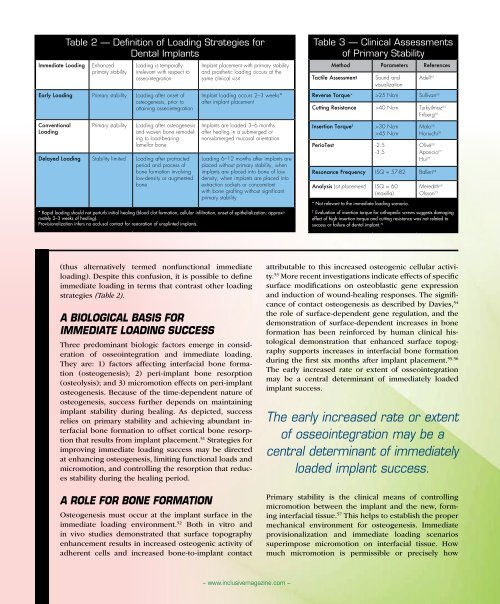PDF Download - Glidewell Dental Labs
PDF Download - Glidewell Dental Labs
PDF Download - Glidewell Dental Labs
You also want an ePaper? Increase the reach of your titles
YUMPU automatically turns print PDFs into web optimized ePapers that Google loves.
Immediate Loading<br />
Table 2 — Definition of Loading Strategies for<br />
<strong>Dental</strong> Implants<br />
Enhanced<br />
primary stability<br />
Loading is temporally<br />
irrelevant with respect to<br />
osseointegration<br />
Early Loading Primary stability Loading after onset of<br />
osteogenesis, prior to<br />
attaining osseointegration<br />
Conventional<br />
Loading<br />
Primary stability<br />
Loading after osteogenesis<br />
and woven bone remodeling<br />
to load-bearing<br />
lamellar bone<br />
Delayed Loading Stability limited Loading after protracted<br />
period and process of<br />
bone formation involving<br />
low-density or augmented<br />
bone<br />
Implant placement with primary stability<br />
and prosthetic loading occurs at the<br />
same clinical visit<br />
Implant loading occurs 2–3 weeks*<br />
after implant placement<br />
Implants are loaded 3–6 months<br />
after healing in a submerged or<br />
nonsubmerged mucosal orientation<br />
Loading 6–12 months after implants are<br />
placed without primary stability, when<br />
implants are placed into bone of low<br />
density, when implants are placed into<br />
extraction sockets or concomitant<br />
with bone grafting without significant<br />
primary stability<br />
* Rapid loading should not perturb initial healing (blood clot formation, cellular infiltration, onset of epithelialization; approximately<br />
2–3 weeks of healing).<br />
Provisionalization infers no occlusal contact for restoration of unsplinted implants.<br />
Table 3 — Clinical Assessments<br />
of Primary Stability<br />
Method Parameters References<br />
Tactile Assessment<br />
Sound and<br />
visualization<br />
Adell 62<br />
Reverse Torque* >25 Ncm Sullivan 63<br />
Cutting Resistance >40 Ncm Turkyilmaz 64<br />
Friberg 65<br />
Insertion Torque †<br />
PerioTest -2.5<br />
-3.5<br />
>30 Ncm<br />
>45 Ncm<br />
Malo 28<br />
Horiuchi 39<br />
Olivé 66<br />
Aparicio 67<br />
Hui 25<br />
Resonance Frequency ISQ = 57-82 Balleri 68<br />
Analysis (at placement) ISQ = 60<br />
(maxilla)<br />
* Not relevant to the immediate loading scenario.<br />
Meredith 69<br />
Olsson 73<br />
†<br />
Evaluation of insertion torque for orthopedic screws suggests damaging<br />
effect of high-insertion torque and cutting resistance was not related to<br />
success or failure of dental implant. 70<br />
(thus alternatively termed nonfunctional immediate<br />
loading). Despite this confusion, it is possible to define<br />
immediate loading in terms that contrast other loading<br />
strategies (Table 2).<br />
A Biological Basis for<br />
Immediate Loading Success<br />
Three predominant biologic factors emerge in consideration<br />
of osseointegration and immediate loading.<br />
They are: 1) factors affecting interfacial bone formation<br />
(osteogenesis); 2) peri-implant bone resorption<br />
(osteolysis); and 3) micromotion effects on peri-implant<br />
osteogenesis. Because of the time-dependent nature of<br />
osteogenesis, success further depends on maintaining<br />
implant stability during healing. As depicted, success<br />
relies on primary stability and achieving abundant interfacial<br />
bone formation to offset cortical bone resorption<br />
that results from implant placement. 51 Strategies for<br />
improving immediate loading success may be directed<br />
at enhancing osteogenesis, limiting functional loads and<br />
micromotion, and controlling the resorption that reduces<br />
stability during the healing period.<br />
A Role for Bone Formation<br />
Osteogenesis must occur at the implant surface in the<br />
immediate loading environment. 52 Both in vitro and<br />
in vivo studies demonstrated that surface topography<br />
enhancement results in increased osteogenic activity of<br />
adherent cells and increased bone-to-implant contact<br />
attributable to this increased osteogenic cellular activity.<br />
53 More recent investigations indicate effects of specific<br />
surface modifications on osteoblastic gene expression<br />
and induction of wound-healing responses. The significance<br />
of contact osteogenesis as described by Davies, 54<br />
the role of surface-dependent gene regulation, and the<br />
demonstration of surface-dependent increases in bone<br />
formation has been reinforced by human clinical histological<br />
demonstration that enhanced surface topography<br />
supports increases in interfacial bone formation<br />
during the first six months after implant placement. 55,56<br />
The early increased rate or extent of osseointegration<br />
may be a central determinant of immediately loaded<br />
implant success.<br />
The early increased rate or extent<br />
of osseointegration may be a<br />
central determinant of immediately<br />
loaded implant success.<br />
Primary stability is the clinical means of controlling<br />
micromotion between the implant and the new, forming<br />
interfacial tissue. 57 This helps to establish the proper<br />
mechanical environment for osteogenesis. Immediate<br />
provisionalization and immediate loading scenarios<br />
superimpose micromotion on interfacial tissue. How<br />
much micromotion is permissible or precisely how<br />
– www.inclusivemagazine.com –

















